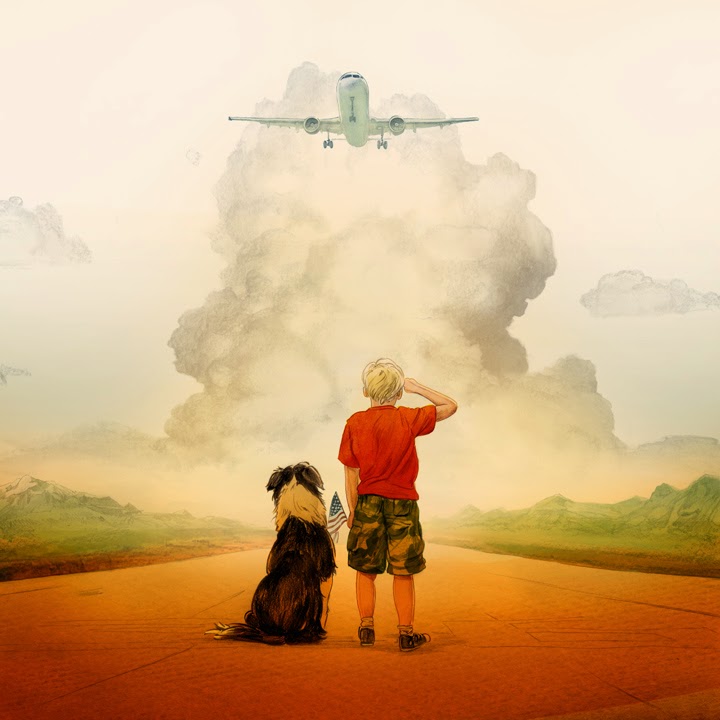 |
| Final cover painting for COMING HOME 2014 |
I have a new children’s picture book out this week called COMING HOME, published and co-created by Jean Feiwel, Liz Szabla, Rich Deas and Molly Broulette at Feiwel & Friends/Macmillan. I say co-created because it was entirely. My name may be the only one on the cover, but all of us stand there together behind every word, page and paper. This week’s post will be about the process from start to finish as an indicator of both how these kinds of things are done, and how they are never done the same.
I was actually working on another story of my own when I was contacted by my publishers at Feiwel & Friends to see if I was interested in taking a break from it to tackle this idea Jean Feiwel had for a book. Her concept was to make a wordless or nearly wordless picture book about a child meeting a returning serviceperson at the airport. It was to be a simple thing, basically about his journey through all the welcoming crowds to find his/her parent and embrace. Seemed pretty easy, right? And frankly a bit of an ego indulgence in that it by its very nature would be almost entirely reliant upon my own craft of making pictures to make it work. Also a burden because it’s failure to do so would be my failure too. So after the flippant joy came and went, the terror of it came through. In any case, my answer was YES. It seemed simple and despite already seeing children’s books as comparatively easy as they sat next to the herculean effort to make a graphic novel, this particular project seemed easier than easy.
Boy howdy was I wrong about THAT.
The first issue to shave down my hubris was the plain fact that while my grandfather may have served in WW2, I had no real bonafides or direct experience with the veteran’s life. Military families abound where I live, but I wasn’t going to be presumptuous enough to assume I would ever have the true understanding of what it meant to see a loved one go off to combat by being friends with those that did. Movies and tv and books provide some astute insight, but really this is a thing known by doing and going through it. How then could I possibly know what it’s like to great a returning parent from war enough to tell that story and be authentic about it? After a week of freaking out, I came to realize that luckily for this book, the experience of the boy was a universal one- and it should be. As much as the story is a celebration of the familial ties that make serving possible, it had to be universal enough to be understood by all of us. A kid being lost in a crowd of adults and then breaking through to reunite with one was the key. We’ve all of us lost our mom’s hand in the grocery store or on a crowded boardwalk, and had the next thirty seconds feel like centuries as we clambered around increasingly panicked looking for them wondering secretly what life alone and orphaned was going to fell like… and then… there they are. That was the core and the key of this. If I just kept to that, it would all be okay.
So, first off I immediately thought of some approaches to get things rolling. The kid would be a boy, because that has become my thing, making books about boys. There aren’t enough books for boys despite how opposite this sounds, and this is largely because girls read tons more than boys do. Good thing too, because I have two boys of my own, so my youngest, Nathaniel got to be the star. I hadn’t done a book with a specific model in this way in a long time, and it was interesting to see him everyday at work like this. I also wanted to flip the usual nature of how we see our soldiers by making our boy’s journey to his parent be one to his mom. Women despite having been serving in the military for many years already, have only recently been afforded some measure of equality and opportunity in the armed forces and I wanted to celebrate and feature that. Plus a boy finding his mom is such a basic and eternally powerful story, it just had to be. So first some sketches and character design had to be taken on. Which was easy as we really only had one main character to worry about. Or so I thought.
Next up was the really tough bit- plotting the book out. We had a simple story to tell, and it had to be told in a few concise pictures that both told us something new with each page turn, kept the momentum going and made the changing landscape of the boy’s journey believable and emotionally relatable. It had to be interesting enough to read and the end had to be powerful enough to survive rereading. Suddenly this easy thing seemed anything but. Cue the new panic.
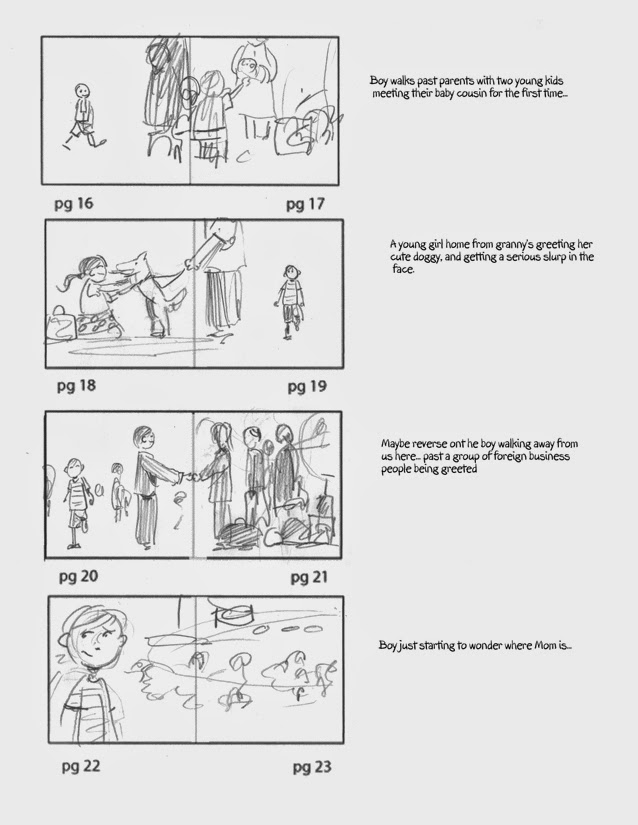
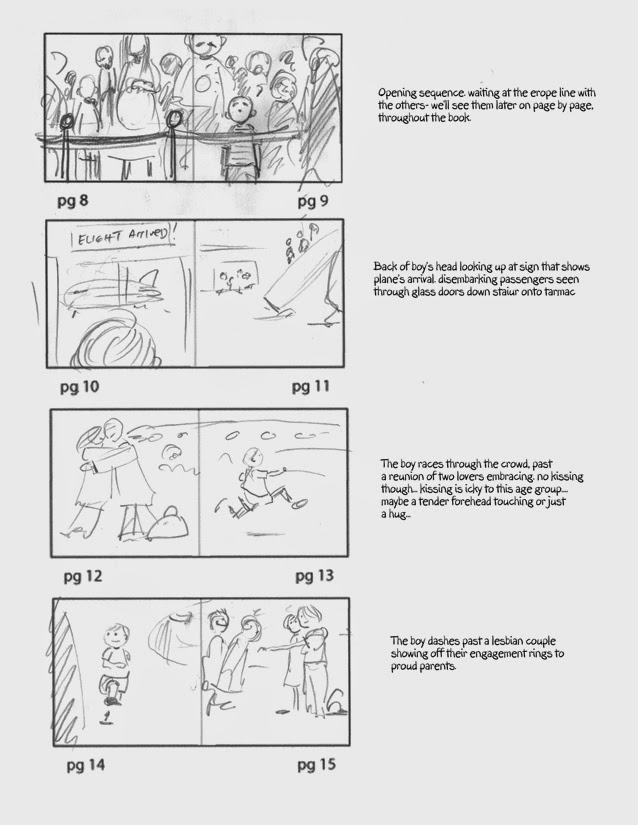
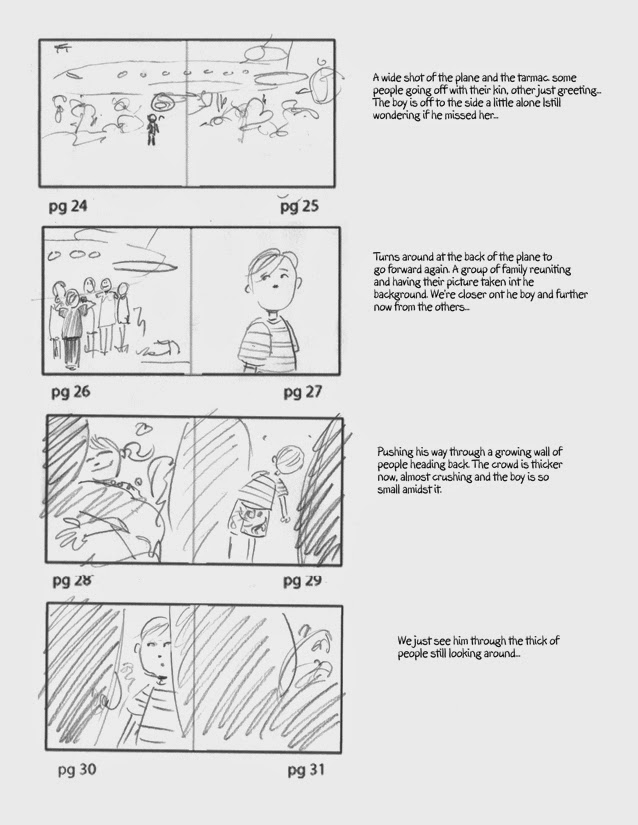
The seconds trick was to realize whomever the boy was standing at the gate with, had to show up later as he moved through the crowds. The dog, the pregnant woman, the older guy and his daughter. It was as much an opportunity as it was a burden. Each then had to have their own coming home arc, even if we didn’t actually see it… we’d feel it it’s lack if it wasn’t there. It also meant I could insert some of my own multicolored realities of our new world I find so personally luminous: That soldiers now meant young and old, black white brown and yellow, men and women and same-sex couples and everything in between. (Oh and I had to put my dog, Pete in there someplace, right?) Thing is each of these individual reunions needed to stay in the background so as not to distract from the main story to tell. So getting over my avoidance terrors it was time to jump in for real and start swimming. I first did this as a list:
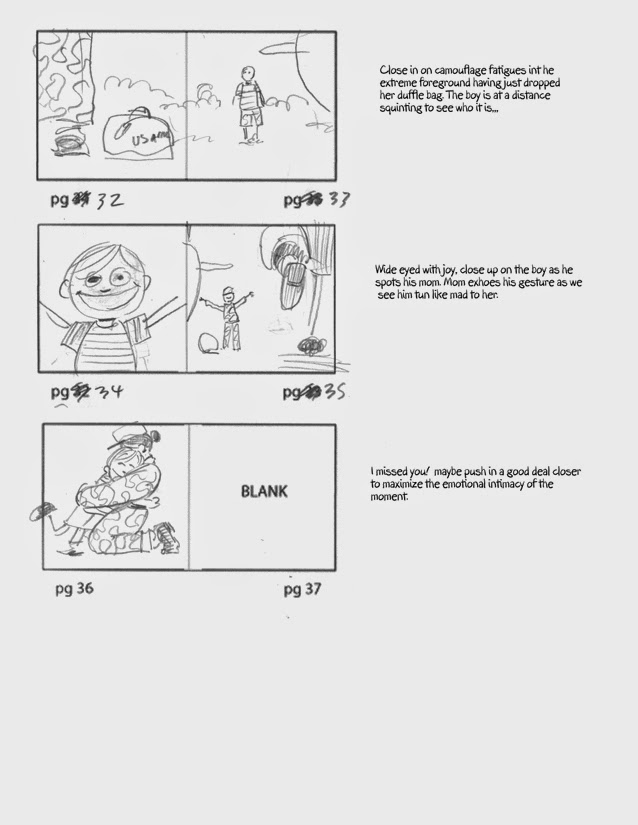
Woman meeting her wife, letting her dog run off first to greet her as she came home.
Older serviceman meeting his granddaughter and swapping hats.
Family reunion picture taken.
Fretting mom reuniting with her son.
Etc… and so on. Not all ended up making it into the book, but having them figured out helped a lot. As an overall editorial rule, it’s easier to trim away than to add later. Editing is at its most effective best, an act of pruning, and I felt certain we’d be in better shape if I overworked it than under. One of the ways to keep us focused on the boy and still get those peeks into the side stories was to keep the “camera” tracking with the boy. This presented it’s own problems though- if it were going to be a book reliant on the pictures to tell the story, I had to make sure we told it in a visually interesting, but still tangibly legitimate way. We had to stay with the boy, but vary how we saw him… sometimes past others and through other reunions. Sometimes up close, and sometimes overhead. The symphony of the story, (and all good stories are symphonies, let’s face it), had to have cadences and high and lows. The emotional music of the book had to be reflected in how the images were portrayed, so that meant understanding how a picture can change its emotion by how its presented, and using that knowledge to craft a movement through the story that would sing the right tune.
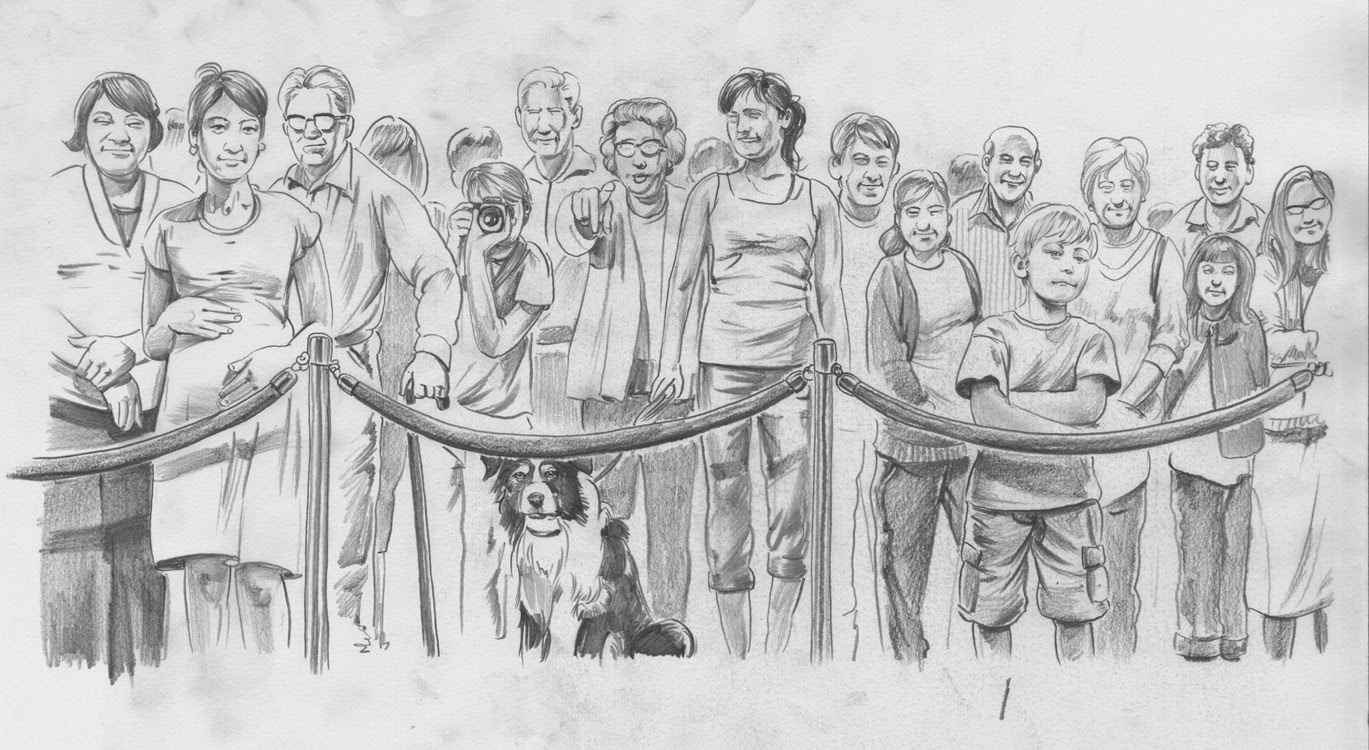 |
| final graphite drawing for opening page |
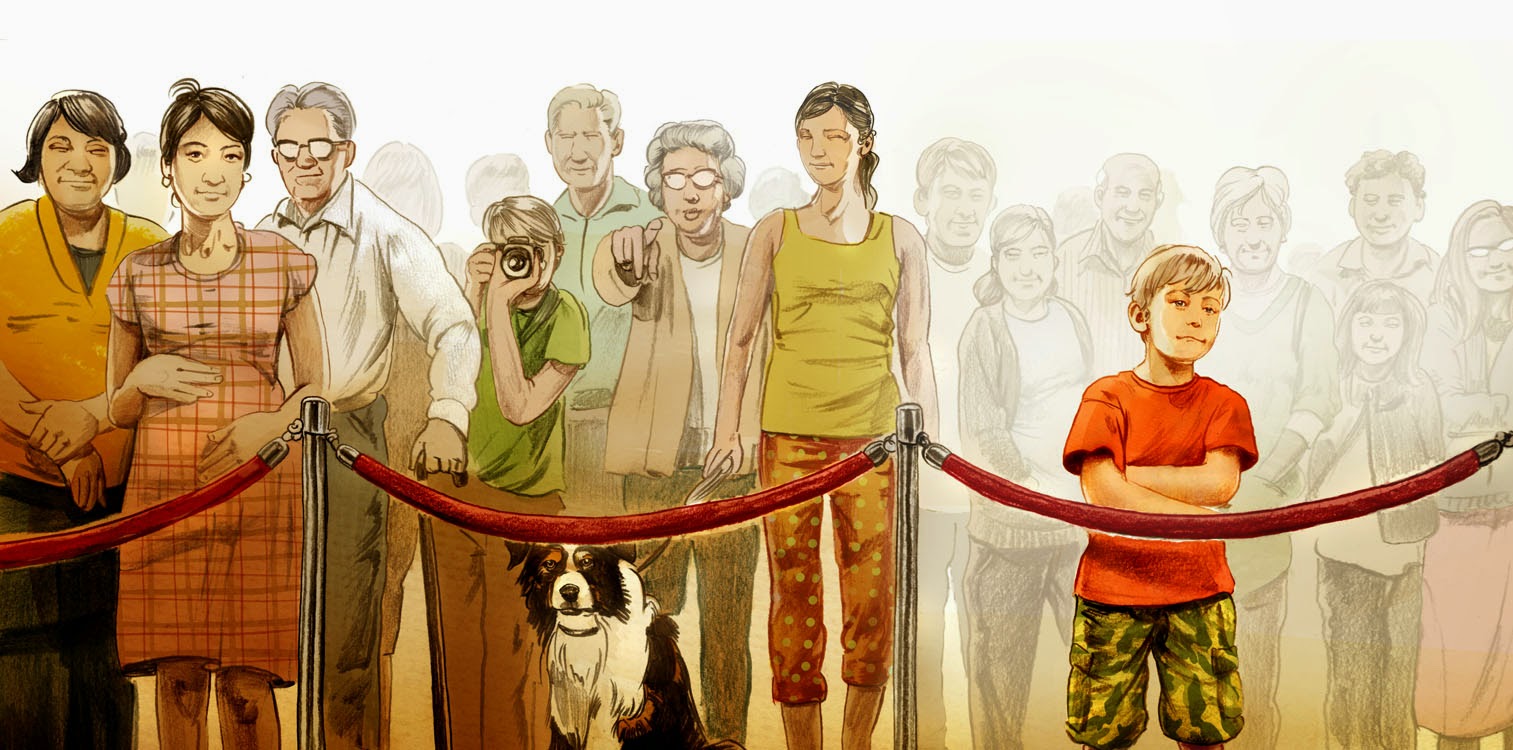 |
| Final painting with colored pencil, watercolor, chalk and finished in photoshop |
When you have a story to tell and only a handful of images to tell it without the crutch of prose to take on the emotion and internal world of the characters, you have to make sure to exhibit authentic emotional states both in the faces of the characters, but in how they are presented compositionally. This bramble of closeups and wanderings turned suddenly to a mild panic had to mean we had only one shot for a full overhead establishing moment. A picture like this is environmental and can easily halt the emotional journey because of its inherent lack of intimacy. But, if used in just the right place, it could offer a change of intimate emotional tones, and have us thrust back down into the fray in the following pages with a new internal landscape.
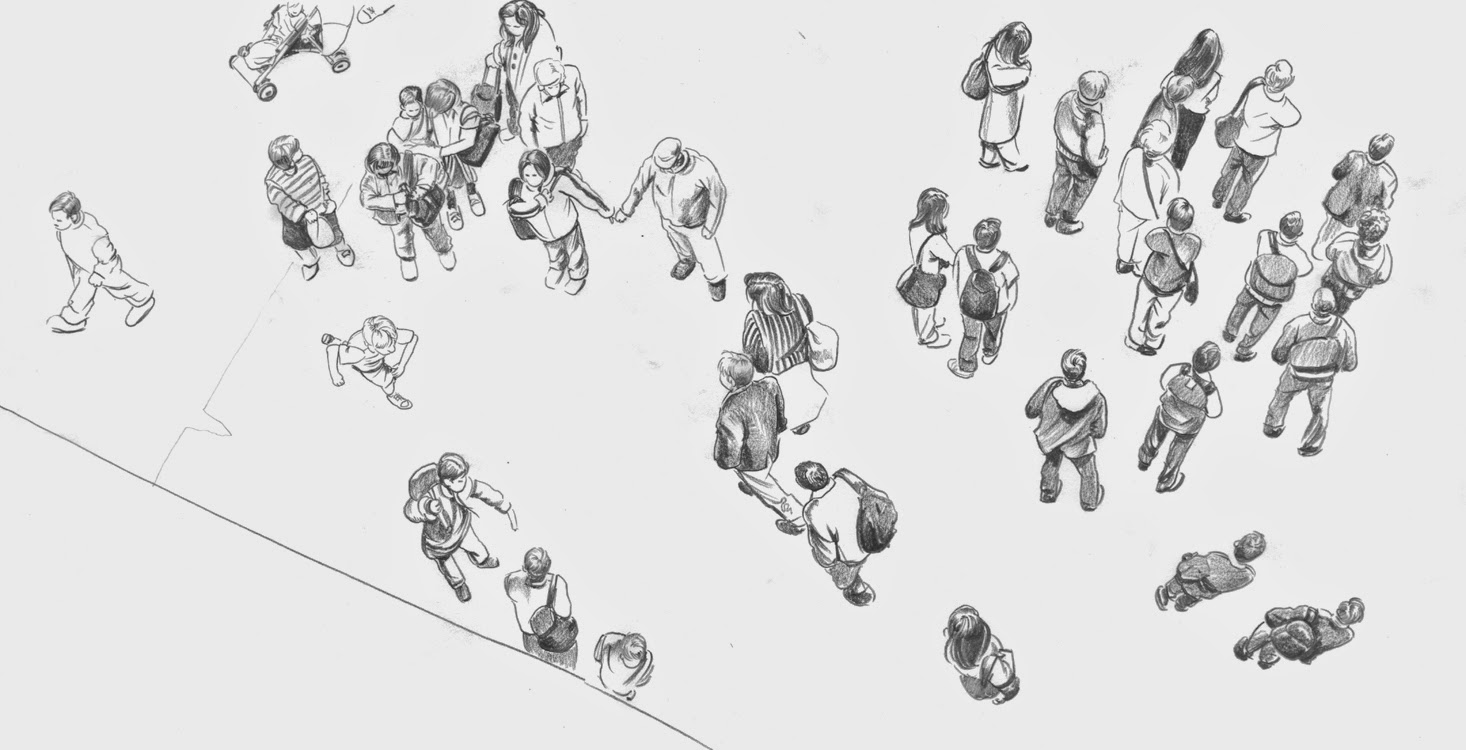 |
| graphite drawing |
This is when the hope of the book turns darker. The crowds closer, almost crushing, the sense of isolation is acute, real and growing. Now it’s a children’s book and with kids these kinds of uncomfortable moments need to be handled diligently, and overall, briefly. You don’t want to dwell too much on this, but just touch it and let the rest unfold. It’s the biggest moment in the book, but it only lasts for a page or two before…
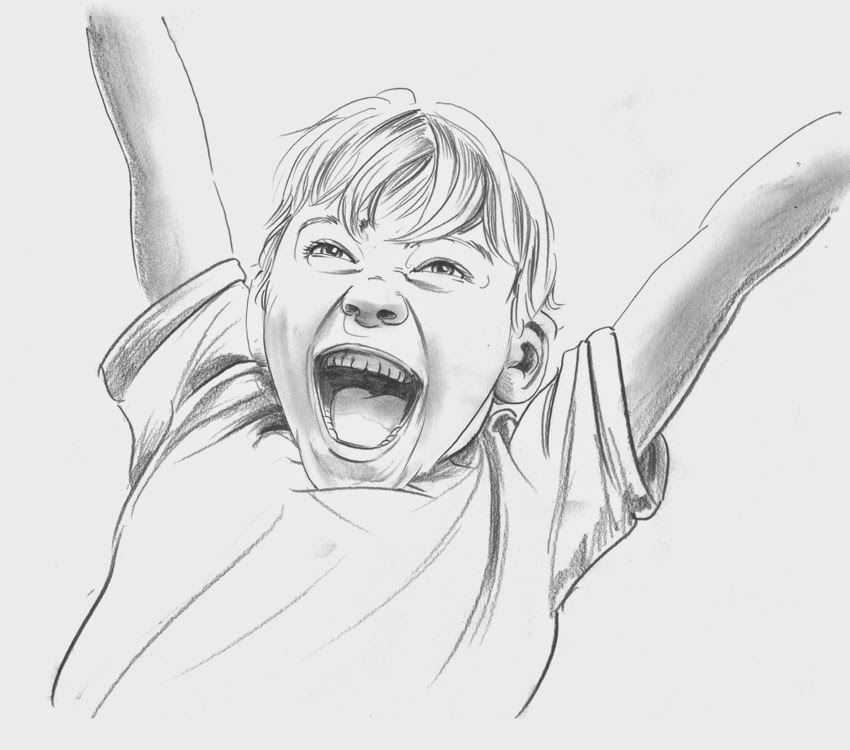 |
| The Nate Face. He’ll do it on command thankfully. |
… He sees his prize! Mom! Then the explosion of joy as the sense of being found comes over and a hard cut to the the embrace as if the distance between them, even if miles apart, was covered lightening fast. Worry, fear, release, joy. This last image was one I spent the most time on, (a close second to the practical difficulties of that overhead shot) because this is where the whole trapeze act landed, and it needed to land perfectly. The spread had to be utilized, if we weren’t going to show the running back to Mom’s arms, so that the left side remained the traversed emptiness. The rest of the world falls away- no more images of the others in the background, the plane or the sense of place. They could be in a basement or on top of a mountain for all that would matter. They at this moment were the only two people in the whole of the world.
Throughout all of this, sketches thumbnails final art and the edits, I was in constant contact with my editor (Liz) and publisher (Jean) as we put this thing together. More often than not I was allowed to run my race, and do my thing. They were amazing in the way the best editorial experiences can be- they made sure to stay ashore while I was allowed to run the line out far towards the ocean’s horizon. They reeled me in when needed, let the line run when necessary. Our previous working relationship and familiarity allowed for a shorthanded trust to occur, as did our consistent communication. When I had a question, I asked it, when they didn’t like an approach, they said it. You can’t make a good anything with others if you can’t have an ego-less back and forth with those collaborators. Anything less than that is a betrayal to the process and the product, in this case, our book.
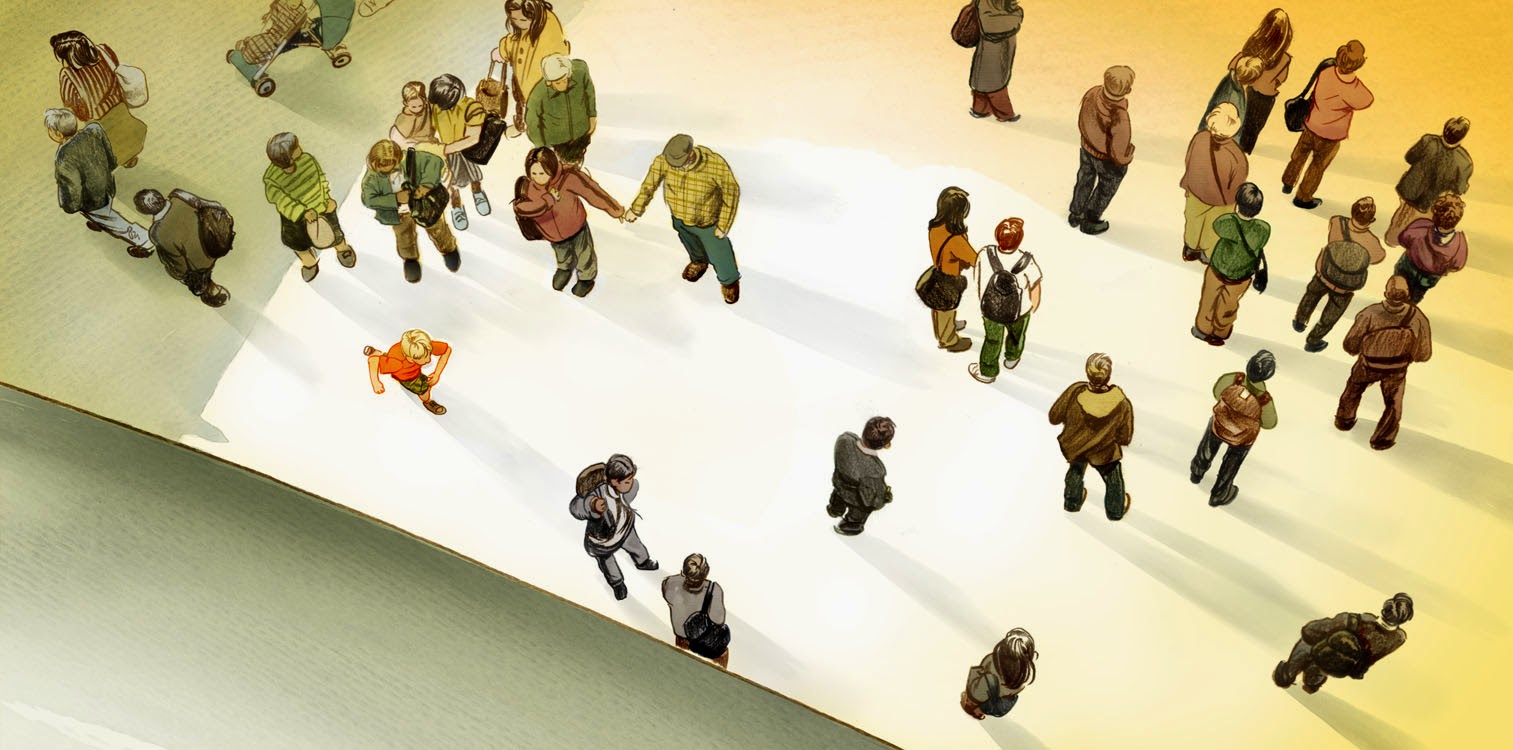 |
| Final piece- largely cut and pasted watercolor and digital finish on this one |
Making the core internal story was tricky but the real trick later was both finding a cover that worked best- we ended up doing two. The first was basically a request from them, and it made sense conceptually, but I think just didn’t play in the end. Rich, my AD on this came in pointing towards my usual trope, the figure standing back to us. Something simple and direct, and so I did. It doesn’t make any practical sense, the boy on the runway with someone else’s dog as a plane came to meet them. If you think about it, it’s insane and ludicrous. Much of this is true for the interior as well. Where is the boy’s dad? is he alone? Do the cops even let people run across an airport tarmac like this? But the trick is really coming to understand the difference between what is factual and what is true. The cover may not be factually plausible, but it’s true to the story. If I’m doing my job right, the average reader either won’t think of these factual questions, or won’t care. The goal of any storyteller is to convince the reader of his or her laws of physics, regardless of what anyone else might say. Suspension of disbelief can only come when the new system of belief is as honest and tangible as the one you’re encouraging them to forget.
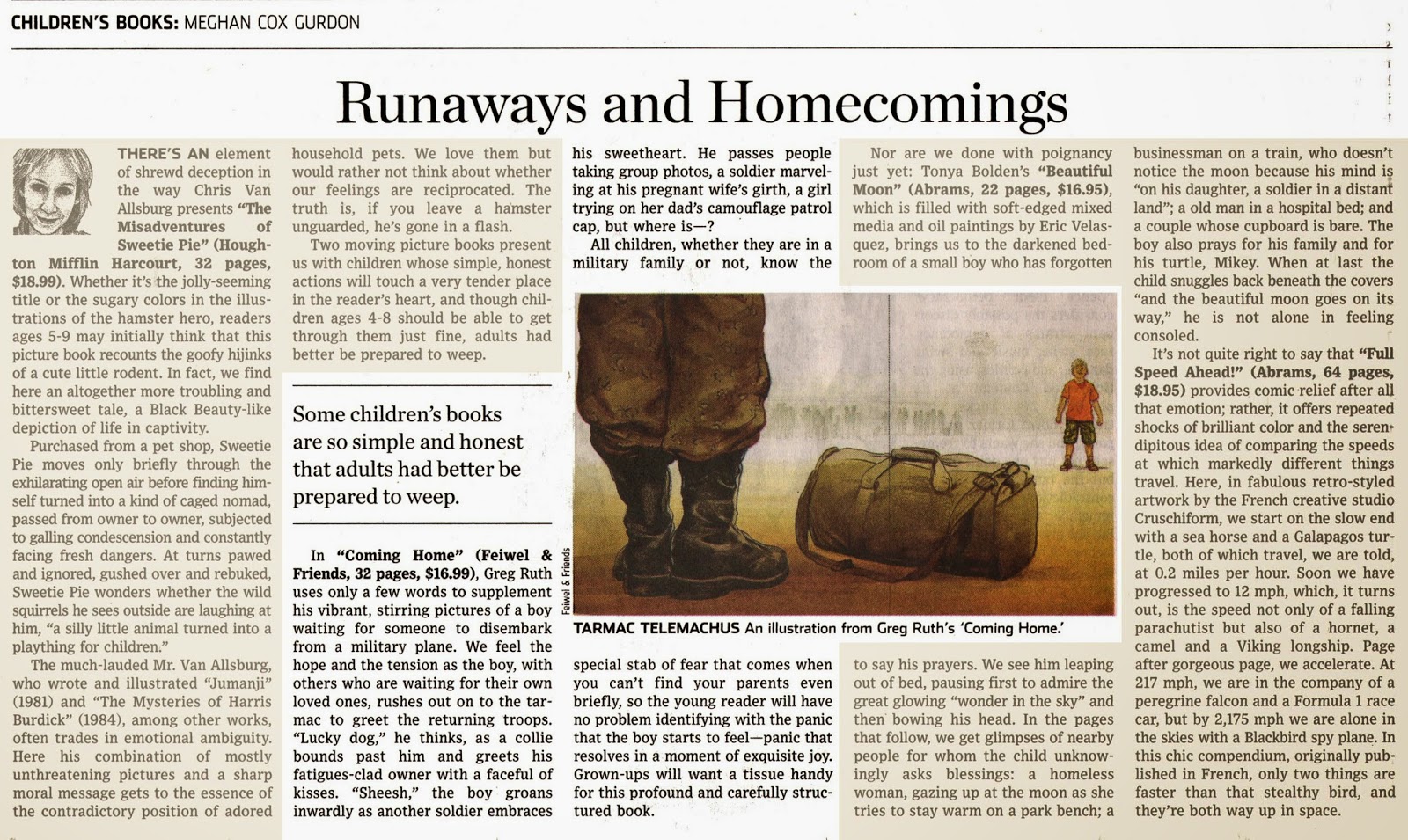 |
| Sunday Book Review from the Wall Street Journal |
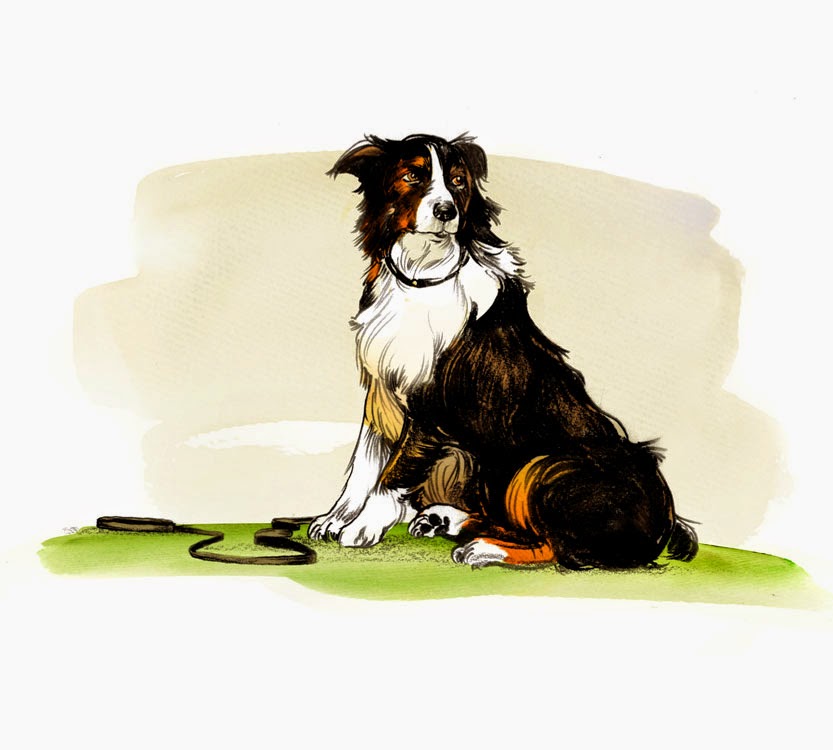 |
| Another slice of artist’s vanity- my studio mate, Pete. Never intended to be in the book, but became a star of it anyway. |


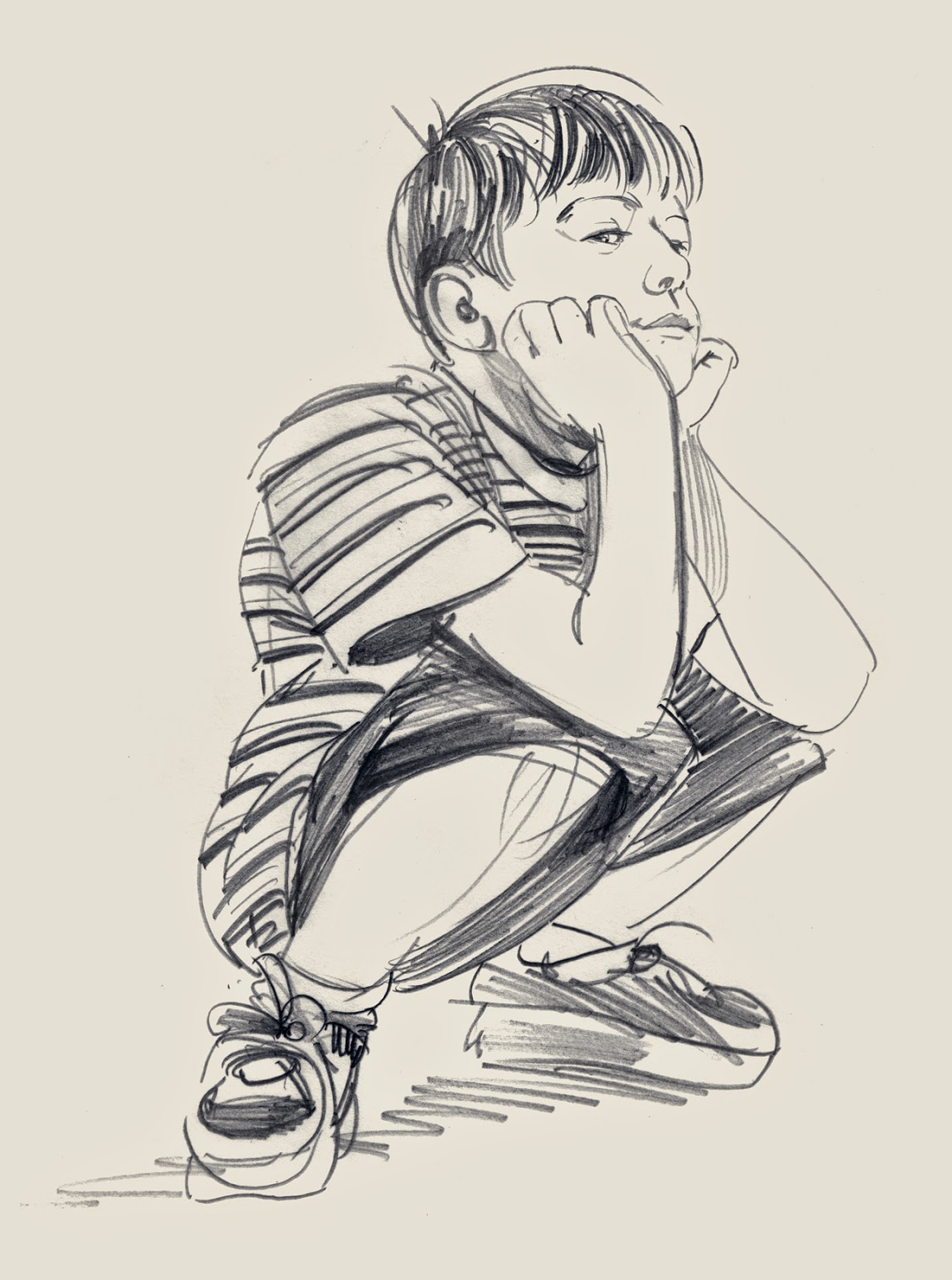
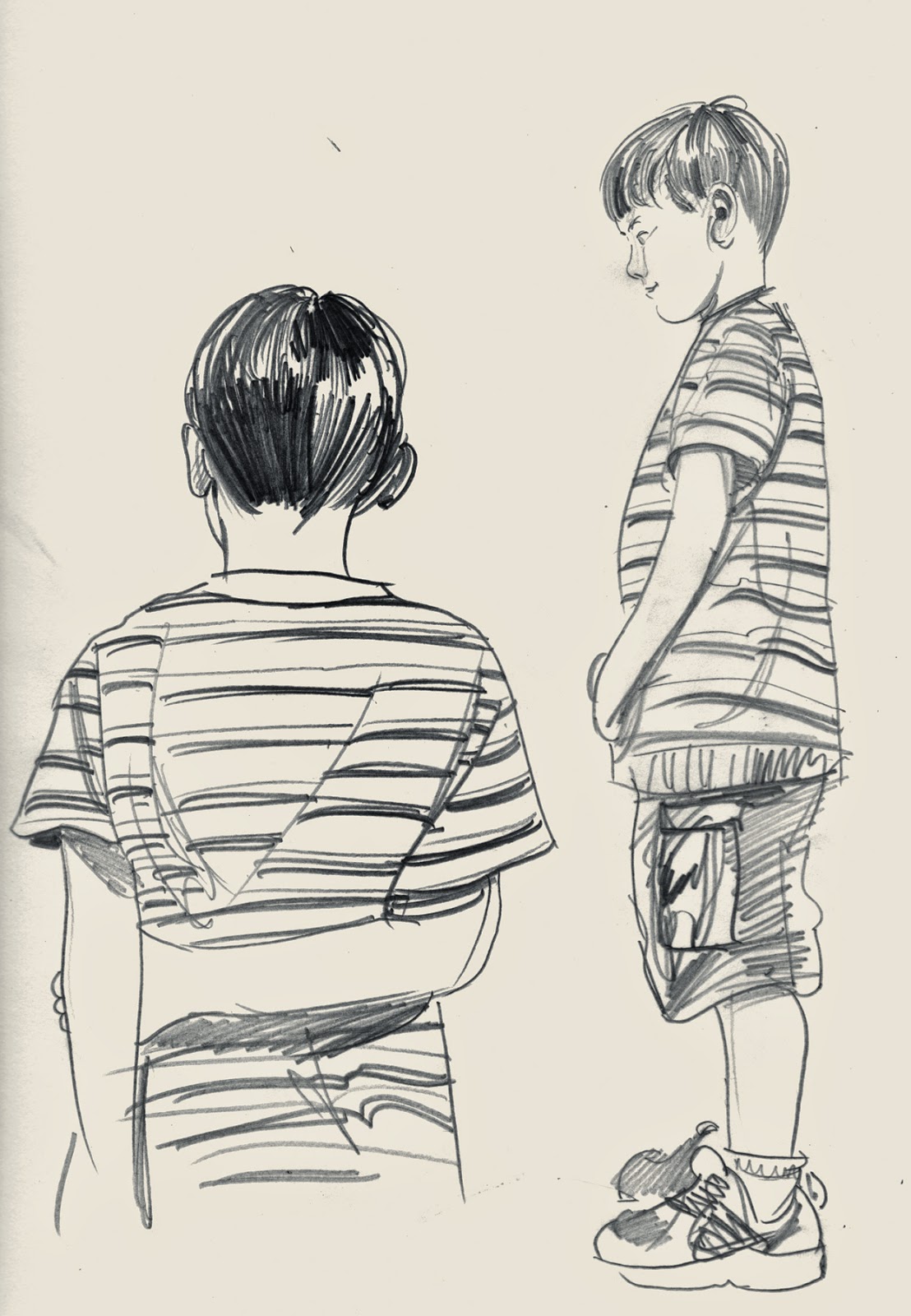
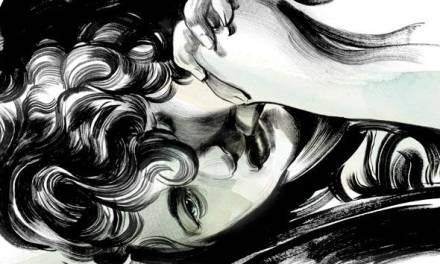
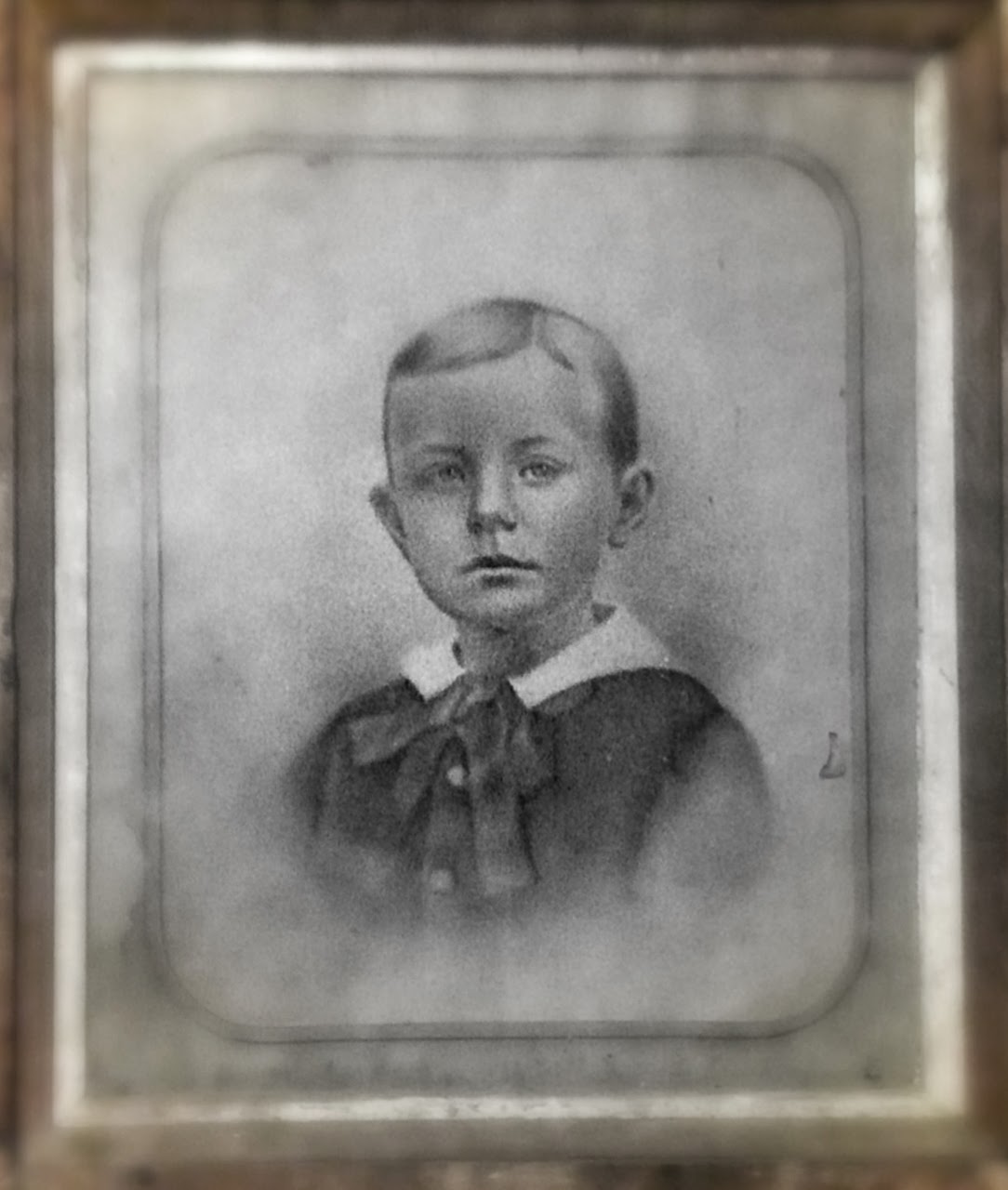
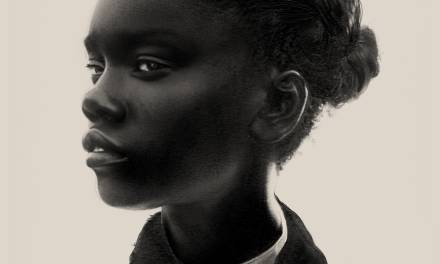
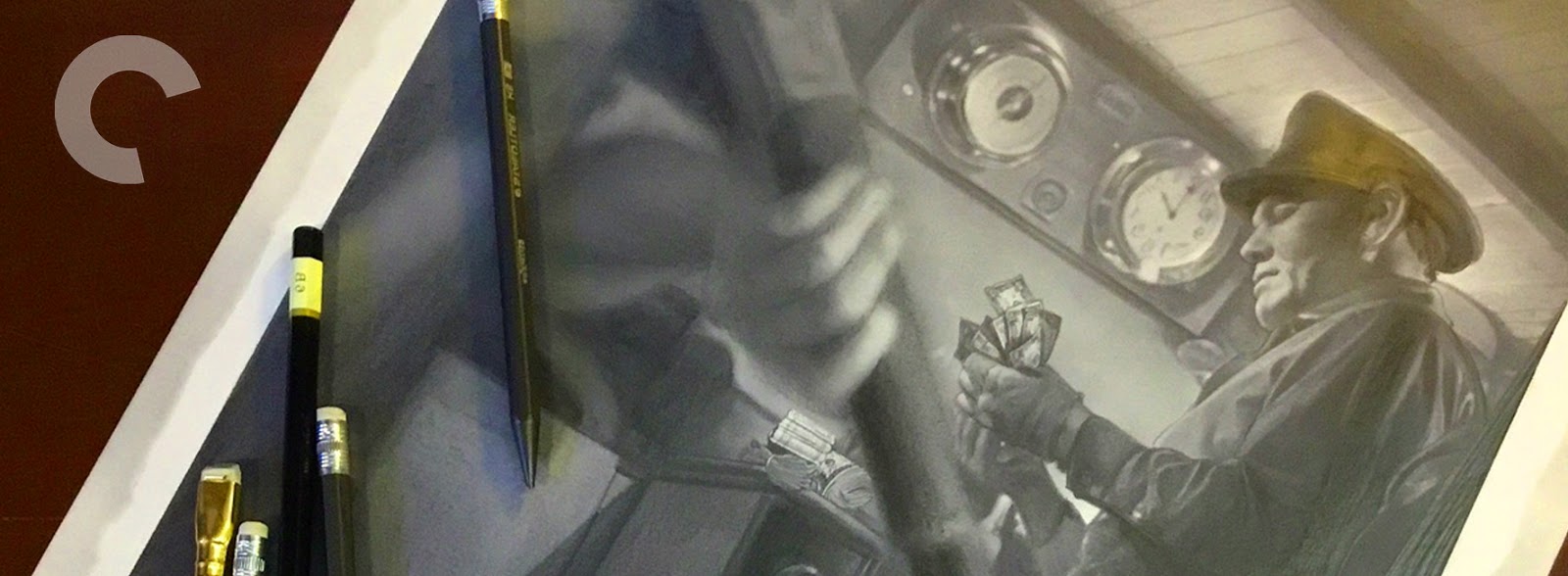
Love seeing the process. And that kiddo's excited face. Wonderful work, Mr Ruth!
My parents never understood why I bought and read children's books. I wish I had had this post 40 years ago. Wonderful. Thank you so much.
What a great post Greg. Thank you.
Thanks everyone- glad the piece hit the right notes. It has been a revelation for myself as well. So. Uch more to do something simple. Starting to rethink how i think about kid's picture books myself!
Fantastic post Greg! I will surely open my eyes as how to approch future children's books projekts.
Thanks!